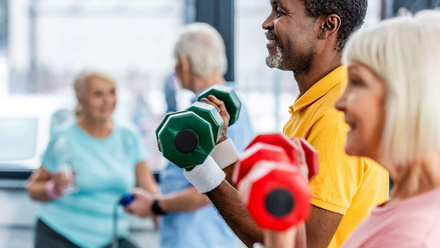Good hydration is one of the most important aspects of the diet – drinking enough liquids to keep the fluid levels in the body topped up helps to ensure that all bodily functions are able to take place as normal. Here, Johanna Hignett looks at how much we need to drink, what kind of drinks to choose and the signs of dehydration.
Why do we need fluids?
Water in the body is essential for many important processes to take place. From our blood system carrying essential glucose, oxygen and nutrients to cells, to the kidneys getting rid of waste products we no longer want, fluid in the body is vital to allow these to occur. It also lubricates our joints and eyes, helps our digestive system function and keeps our skin healthy.
We are uniquely designed to regulate our own body temperature, particularly in hot conditions, by losing more water through the skin (perspiration), which in turn acts to cool the body helping to maintain a stable temperature. The more water we lose through sweat, the more we need to replace, so those who live (or holiday) in a hot climate, or lose more fluid than normal doing sporting activities will need to drink more fluids more regularly to replace that lost through sweat.
Water levels in the body change as we age, with newborns having a higher body fluid level compared to adults. Elderly people have lower fluid levels still, but hydration is really important at all ages.
Why do we need to keep hydrated?
Fluid is so important in the body that even when levels drop only slightly, we begin to feel the consequences. Low levels of fluid in the body can cause headaches, feelings of dizziness, lethargy, poor concentration and a dry mouth. Over a longer term, dehydration can cause constipation and can be associated with urinary tract infections and the formation of kidney stones. Regular and adequate intakes of fluid can help to address these.
How much do I need?
Adults need to drink around 1.5–2 litres of fluid a day. A typical mug or glass is about 200 millilitres (ml) so this equates to 8-10 drinks a day. Children need slightly less and should aim for around 6-8 drinks a day, but once they reach teenage years their requirements are similar to adults. Don’t forget that fluid needs can vary depending on various factors including level of physical activity and climate, so it is best to remember to drink regularly to keep thirst at bay. A few groups (listed in the box below) need to take particular care to make sure their fluid levels are kept topped up and these include:
Children: Often too busy to recognise the signs of thirst!
Pregnant and breastfeeding ladies: Fluid is critical for baby and breastmilk
Older people: Often don’t drink enough
Athletes: Need regular fluid top ups as they lose more through sweat
How do I know I'm drinking enough?
Simply waiting for the sensation of thirst is not a good enough sign of a need to drink – by the time we feel thirsty our body is already dehydrated and potentially suffering some of the effects. Equally, simply drinking to eliminate the feeling of thirst does not fully hydrate the body.
The best indicator of good hydration is urine colour, a pale straw coloured urine being a reliable indicator of good hydration. Darker coloured urine is a sure sign that the body needs more fluid. Getting into the habit of drinking regularly is a great way of keeping hydrated.
What drinks count?
Simply, any drink will help to promote hydration. Water from the tap is a great choice, not least because it’s readily available and free. Other drinks count towards our total fluid intake too; milk, fruit juice, tea, coffee and soft drinks are all over 85% water and can be included in total fluid intake.
Some drinks contain other nutrients in addition to fluid such as sugars, fats, vitamins and minerals. Fruit juice is one such drink with vitamins, minerals and sugars too. A glass does contribute to fluid intakes and also provides one of the recommended five portions of fruit and vegetables. Don’t forget that the recommended portion is 150ml though, and only one glass of fruit juice counts each day. Regularly choosing drinks with higher levels of added sugars can cause dental problems and is also associated with an increased risk of developing Type 2 diabetes, but there are plenty of sugar free choices available today as alternatives. Finally, if you are
choosing sugary drinks try to have them at meal times to limit any problems with dental health.
Drinks with added cream and/or full fat milk provide more calories and higher fat intakes are not generally recommended within healthy eating guidelines, so drinks like creamy hot chocolates are best considered to be treats!
There has been confusion about coffee in particular, with some wrongly thinking it does not hydrate the body as it contains caffeine. Although caffeine is a mild diuretic, the fluid provided by a cup of coffee or tea far outweighs the mild dehydrating effect of caffeine and the fluid levels in the body are improved.
Most of the fluid we consume comes from drinks, but around 20–30% comes from foods. Many fruit and vegetables such as courgettes, cucumber, tomatoes and melon are over 90% water and make a valuable contribution to our overall fluid intake.
Sporty moves
An adequate fluid intake is critical for sports people, principally because their losses of fluid through sweat during activity are increased. It is well known
that performance in athletes can drop if fluid levels are not adequate. Athletes often choose isotonic sports drinks to replace both fluid and salts lost through sweat. In fact, regular drinking is as much part of their training as their diet and physical strength. However, most of us who enjoy occasional sport, gym classes, or recreational running don’t need the more expensive sports drinks and are best choosing water to keep our levels of hydration up. Remember to take a bottle of water with you when you go for a walk, to the gym, for a run or game of football or rounders and drink a little every now and then!
Don't forget
Good hydration is critical to health and keeps our bodies performing at their best, not only in terms of all the processes that go on but also keeping our levels of concentration up. The best advice is to keep a bottle of water close by to top up fluid levels regularly and keep thirst away.







